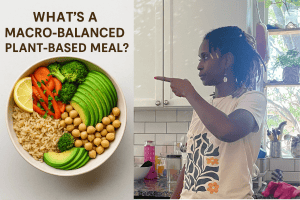
What This Post Is About:
In this post, I share how I follow Dr. Fuhrman’s Nutritarian protocol known for its focus on whole, plant-based foods—while adapting it to meet my personal gut health needs. If you’re managing food sensitivities or working with Viome results like I am, this post will help you apply Nutritarian wisdom without sacrificing your digestion or energy. I believe that the Nutritarian Diet is essential for achieving a balanced lifestyle.
1. Why Dr. Fuhrman’s Nutritarian Approach Makes So Much Sense
I’m currently studying to become a certified vegan nutritionist, and one of the protocols that truly aligns with my values and knowledge is Dr. Joel Fuhrman’s Nutritarian Diet. It’s grounded in science, focused on longevity, and built around the idea that food should heal, not harm our bodies.
Dr. Fuhrman’s philosophy is simple: nutrient density is the key to optimal health. That means every bite should be packed with vitamins, minerals, antioxidants, and fiber, while avoiding things that cause inflammation or nutrient depletion.
What I love most:
- Mostly raw, whole, plant-based foods
- No animal products, no protein powders, no fake meats
- Low in gluten, starches, and processed carbs
- Zero oil, added sugars, or salt-heavy ingredients
- A strong emphasis on greens, mushrooms, onions, berries, and seeds (the famous G-BOMBS)
- Tasty, satisfying recipes you can actually enjoy
And here’s the cool part: Dr. Fuhrman is not just a doctor, he’s also a former professional ice skater. His energy, fitness, and lean physique prove that you don’t need crazy amounts of protein or supplements to stay strong and toned. In fact, in one of his videos, he explains that you can build normal, healthy muscle mass with a plant-based, nutrient-rich diet, even without a ton of protein.
2. But Here’s the Challenge: My Gut Doesn’t Like Some of the Key Foods
As much as I adore the Nutritarian blueprint, my Viome gut health test revealed that several of the staple foods in his plan just don’t work for me.
Here are the ingredients I need to limit or avoid:
- Cashews
- Tomatoes
- Broccoli and cauliflower
- Brussels sprouts
- Beans and lentils
- Tofu
These are common in Nutritarian recipes, especially as protein sources or salad add-ins. But if I follow the plan 100% by the book, I risk triggering bloating, inflammation, or gut imbalance.
3. How I Adapt the Nutritarian Plan to Support My Gut
Instead of abandoning this approach, I decided to make it mine, keeping the principles but adjusting the ingredients.
Here’s what that looks like in my daily routine:
a.🥗 Big Salad for Lunch (Non-Negotiable)
This is the heart of every Nutritarian day, and I love it.
- 1 cup green lettuce
- 1 cup kale
- ½ cup arugula
- Chopped green onions or red onions
- Raw or steamed zucchini, cucumbers, or grated carrots
- A handful of pumpkin seeds or sunflower seeds
- Homemade oil-free dressing made with avocado, nuts (not cashew), or tahini
This salad is colorful, crunchy, and loaded with fiber. Sometimes I add lightly sautéed mushrooms or roasted sweet potatoes for extra comfort.
b.🍄 Mushrooms Daily
Dr. Fuhrman calls mushrooms “immune powerhouses,” and I aim to include ½ cup cooked mushrooms daily, either in soups, scrambles, or sautéed over greens.
c.🍵 Soup or Stew for Dinner
Instead of protein-heavy meals at night, I opt for veggie-forward soups, such as:
- Carrot-ginger soup
- Zucchini & squash stew
- Cabbage with herbs and miso
- Split pea (just ½ cup max lentils or beans when used)
This light dinner gives my digestion a rest, while still being warming and satisfying.
d.🧠 No Protein Powders
Unlike many plant-based fitness plans, this one doesn’t rely on protein shakes. And I love that. I get my protein from nuts, seeds, greens, and the limited legumes I tolerate.
e.💡 No Overeating + No Snacking After Dinner
Dr. Fuhrman emphasizes intuitive eating and avoiding excessive calories from snacking. I’ve applied this to my own rhythm, focusing on 2–3 nutrient-rich meals a day and closing the kitchen early.

4. Bonus: His Online Recipe Database is a Goldmine
If you get a Dr. Fuhrman membership, you unlock a vast collection of recipes, all searchable by:
- Keywords, Ingredients
- Meal type (breakfast, soup, salad, dessert)
They’re all whole-food plant-based, oil-free, and super creative. I often get inspired by his recipes and then swap out the ingredients I can’t tolerate to stay Viome-compliant.
5. Why This Still Works (Even With My Modifications)
Even though I’m not following it 100% word-for-word, the Nutritarian mindset has changed my approach to food:
- I crave greens, not carbs.
- I feel clean and light, not stuffed or sleepy.
- I eat less, but feel more nourished.
- I’m building muscle with natural food, not powders or fake meats.
That’s what I want to teach other women, too: you can personalize a system to your body, and still get amazing results.
6. Final Thoughts
Dr. Fuhrman’s Nutritarian protocol is powerful, especially for anyone ready to heal their body with food. And while it wasn’t a perfect fit for me right out of the box, the core concepts were too valuable to let go. So I took what worked, left what didn’t, and built a gut-happy, plant-strong system that supports my energy, digestion, and goals.
Whether you’re starting a high-raw lifestyle, managing food sensitivities, or just curious about a no-nonsense plant-based plan, this is a path worth exploring, and adapting to your own life.
Ready to build your personalized plant-powered meal plan?
Stay tuned for my next post where I’ll share how my PowerPlant Mama AI meal planner makes Nutritarian-style eating easy, gut-friendly, and delicious for busy moms like us 💪🌱
7. Frequently Asked Questions
What do I eat in a day as a Nutritarian?
A typical Nutritarian day focuses on high-nutrient, whole plant foods with little to no processed ingredients. Here’s an example:
– Breakfast: Fresh fruit or a vegetable-rich smoothie
– Lunch: A large salad with leafy greens (like kale, romaine, arugula), raw veggies, beans or seeds, and an oil-free nut-based dressing
– Snack (optional): A piece of fruit, a few nuts, or raw veggies
– Dinner: A hearty vegetable soup, steamed greens, or a simple cooked dish like squash, mushrooms, and legumes
Desserts (if any) are made from whole ingredients like dates, nuts, and fruit—no added sugars or oils.
Can you eat eggs on a Nutritarian diet?
No, eggs are not included in a Nutritarian diet. The Nutritarian approach is plant-based and free of animal products, including eggs and dairy. The focus is on maximizing nutrient density from plants, minimizing inflammation, and promoting long-term health. For protein, Nutritarians rely on beans, legumes, nuts, seeds, and greens.
What does a Nutritarian eat for breakfast?
Breakfast on a Nutritarian plan is usually light, fresh, and rich in fiber and antioxidants. Some common options include:
– A bowl of mixed berries and sliced fruit
– A green smoothie with spinach, banana, berries, and flax or chia seeds
– Raw oatmeal or chia pudding made with unsweetened plant milk and topped with fruit and nuts
The goal is to start the day with foods that energize and nourish without processed carbs, sugar, or oil.
Is the Nutritarian diet healthy?
Yes, very healthy. The Nutritarian diet is designed to prevent chronic diseases, support weight loss, reduce inflammation, and promote longevity. It’s backed by science and emphasizes nutrient-dense foods like leafy greens, cruciferous vegetables, berries, beans, mushrooms, onions, and seeds. It excludes processed foods, sugar, oil, and animal products, making it one of the most anti-inflammatory and healing diets available today.




